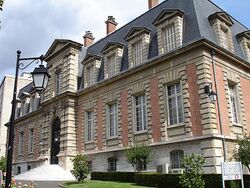France/Biological weapons
(Biological weapons) | |
|---|---|
 The headquarters of the Pasteur Institute in Paris | |
| The French government is still highly secretive about this research . |
The French biological weapons program has had several breaks during its 100 year existence, most notably during World War 2 and after the beginning of the 70s, when the Biological Weapons Convention was signed. Since then, it has continued on smaller scale as a "defensive" program, possibly outsourced to private medical companies. The French government is still highly secretive about this research .
Contents
History
The first scientific researches were undertaken by Louis Pasteur who, after having developed his “germ theory of diseases”, experimented with the destruction of rabbits with the microbe chicken cholera in 1887.
During World War 1, the veterinary services of the French and German armies recorded respectively 60,000 and 30,000 cases of glanders in their horses during the war without it being possible to determine what is natural origin and what is caused by biological warfare.[1]
From 1921 to1940, French teams worked on this question, in collaboration with the Pasteur Institute.[2]
In 1938 experiments on the dispersion of a "harmless bacterium" (Bacillus prodigiosus) were carried out secretly in the Paris metro, on two lines. At the beginning of 1940, testing took place on sandbanks in the Bay of Somme in Northern France.[2]
When the Germans occupied Paris in 1940, they found plans for the use of the Potato beetle as a biological weapon.
After WW2
A broad spectrum program resumed in 1947, which included the development of weapon systems. Interest in this type of weapon was then revived by the documents seized in Germany after the defeat of the Nazis. After the Second World War, several laboratories were involved in the research: the veterinary laboratories of the army of Tarbes (Hautes-Pyrénées) and Maisons-Alfort (Val-de-Marne), those of the technical service of the army in Aubervilliers (Seine Saint-Denis) and the Bouchet Study Center in Vert-le-Petit (Essonne).[2]
The French program at first never involved more than fifteen researchers, mainly military veterinarians. "In the initial phase, the biological agents selected were botulinum toxin, rici and anthrax", according to historian Olivier Lepick. A test campaign, carried out from 1948 to 1952, gave "mixed" results. However, official reports stated that “the tests made it possible to validate the serious infection of war wounds by the use of contaminated devices, the infection at the pulmonary entryways, as well as the creation of enzooties [animal epidemics] by the dissemination of pathogenic germs.".[2]
A 1954 report on "Directions for Research on Microbial Warfare" spelled out what these secret weapons could be used for. On the battlefield, for example, it would be a question of "increasing the severity of injuries and consequently causing congestion in hospitals". At the strategic level, the targets would have been "sensitive military and civilian areas, training camps, sea bases, important towns, supply centers, breeding regions and industrial centers". The army planned to develop various shells (105 mm, 120 mm, 155 mm), aviation bombs of 250 and 50 kg, bouncing mines and aerial spraying means.[2]
In 1956, France decided to acquire the atomic bomb. Immediately, this choice caused a drastic reduction in the appropriations of the chemical and biological programs. In 1962, the decision was taken to relaunch "a vigorous biological military program", after the French discover the state of progress of the American and Soviet programs. Hence the revival: for a few months, the army will develop a program of "incapacitants" based on staphylococcal enterotoxin and Brucella arbotis. It's about making enemy soldiers sick, not killing them.[2]
But, from 1964, the program "fell into disuse", again for budgetary reasons. Thus, "France is gradually abandoning the offensive component of its program and retains only strictly defensive activities," notes Olivier Lepick. In 1972, the signing of the Washington treaty banning biological weapons "only legally endorsed an implicit decision" to abandon it. Since then, “defensive” research has continued at the Bouchet Study Center. Unlike the United States, Japan and the Soviet Union, France never produced weapons industrially, and the army was therefore not equipped with them.[2]
Rating